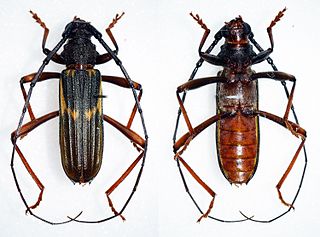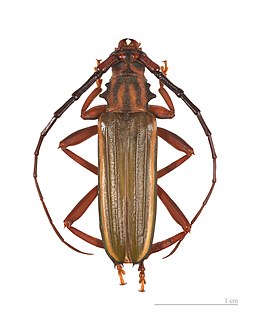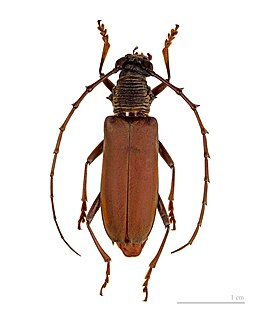
Bothriospilini is a tribe of beetles in the subfamily Cerambycinae. The tribe was proposed in 1950 by Brazilian entomologist Frederico Lane as a member of the new subfamily Bothriospilinae, and with Bothriospila assigned as the type genus. The tribe is morphologically close to the tribe Torneutini, with which it has in common the same shape of the last abdominal segment, which is wide and largely braided in the female, as well as the anterior thigh cavities that are open from behind and the laterally open medial cavity.

Chlorida is a genus of beetles in the family Cerambycidae, containing the following species:

Jupoata is a genus of beetles in the family Cerambycidae, containing the following species:

Eburodacrys is a genus of beetles in the family Cerambycidae, containing the following species:
Ectenessa is a genus of beetles in the family Cerambycidae, containing the following species:
Piezophidion is a genus of beetles in the family Cerambycidae, containing the following species:
Compsibidion is a genus of beetles in the family Cerambycidae, containing the following species:
Minibidion is a genus of beetles in the family Cerambycidae, containing the following species:
Temnopis is a genus of beetles in the family Cerambycidae, containing the following species:
Gorybia is a genus of beetles in the family Cerambycidae, containing the species:
Eupromerella is a genus of beetles in the family Cerambycidae, containing the following species:
Nesozineus is a genus of beetles in the family Cerambycidae, containing the following species:
Abacetus pumilus is a species of ground beetle in the subfamily Pterostichinae. It was described by Boheman in 1848. Abacetus pumilus is a small, but distinctive, beetle with red legs and antennae, and a green tinge on its wings. Very little is known about Abacetus pumilus habitat, however it is found throughout the arid deserts and semi-arid steppes of southern Africa.

Chlorida cincta is a species of beetle in the family Cerambycidae. It was described by Félix Édouard Guérin-Méneville in 1844. It is known from Mexico, Colombia, and Ecuador.

Chlorida festiva is a species of beetle in the family Cerambycidae. It was described by Carl Linnaeus in his landmark 1758 10th edition of Systema Naturae. It is known from southeastern United States, Central America, South America, and the West Indies. Adult males produce (6E,8Z)-6,8-pentadecadienal, an attractant pheromone. In Puerto Rico the larvae are known to be leaf mining pests of mango crops.
Chlorida spinosa is a species of beetle in the family Cerambycidae. It was described by Per Olof Christopher Aurivillius in 1887. It is known from Colombia, Bolivia and Peru. Adult males produce (6E,8Z)-6,8-pentadecadienal, an attractant pheromone.
Clausirion bicolor is a species of longhorn beetle in the family Cerambycidae. It was described by Galileo and Martins in 2000. It is endemic to Bélizon, French Guiana where it flies from August to September. It is 24 millimetres (0.94 in) long and have black coloured antennae. legs, and prothorax.
Punctozotroctes is a genus of beetles in the family Cerambycidae, containing the following species:
Punctozotroctes inhamum is a species of beetle in the family Cerambycidae. It was described by Martins, Galileo and Limeira-de-Olveira in 2009.
Ischnolea inexpectata is a species of beetle in the family Cerambycidae. It was described by Galileo and Martins in 1993. It is known from Brazil.




